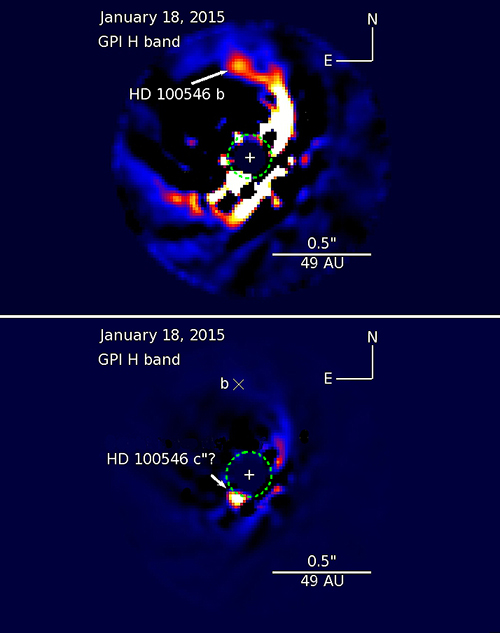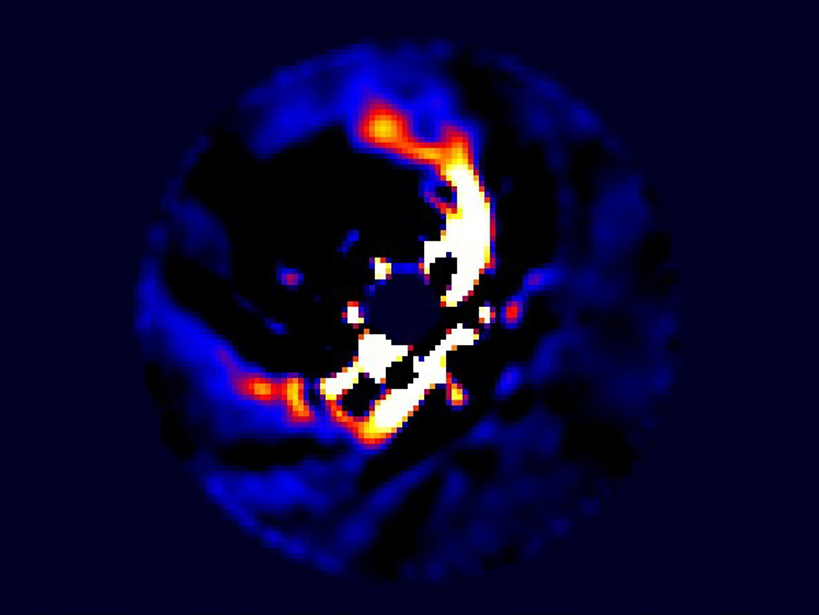For nearly a decade, astronomers have taken pictures of young planets orbiting stars beyond the solar system. However, the very first page in the exoplanet photo album—the portrait of an infant—remained blank.
The babies are still feeding off of material from their birth clouds—swirling disks of gas and dust that encircle their young parent stars.
Now two teams of researchers have independently taken the first-ever snapshots of infant planets still nestled in the womb around their parent stars. Images of the fledgling planets, which reside in separate star systems a few hundred light-years from Earth, reveal that the babies are still feeding off of material from their birth clouds—swirling disks of gas and dust that encircle their young parent stars.
The recently published findings have come out in rapid succession within weeks of the 20th anniversary of the 23 November 1995 publication of the discovery of the first planet orbiting a Sun-like star.
“These two discoveries are showing us, for the first time, a new piece of the puzzle to understand the planet formation process,” said Christian Marois of the National Research Council of Canada’s Herzberg Institute of Astrophysics in Victoria, British Columbia, who was not part of either study.
Confirmation and New Candidate
One of the teams, led by Thayne Currie of the Subaru Telescope in Hawaii, an instrument of the National Astronomical Observatory of Japan, examined candidate planets circling the young star HD 100546, about 320 light-years from Earth. Currie and his colleagues used the Gemini Planet Imager, an instrument that takes the twinkle out of starlight—the blurring caused by Earth’s turbulent atmosphere—to confirm the existence of one planet and find tentative evidence of another. They reported their findings in the 1 December issue of Astrophysical Journal Letters and also described their results on Tuesday at a conference on exoplanets in Hawaii.

The confirmed planet, first identified in 2013 and known as HD 100546 b, lies about 47 astronomical units (AU) from its parent star, farther than Pluto’s distance from the Sun (1 AU is the distance between Earth and the Sun). The parent star is a youthful 10 million years old (our middle-aged solar system is 4.56 billion years old) and still retains part of its doughnut-shaped planet-forming disk. Moreover, the reddish color of the planet, observed at infrared wavelengths, hints that this infant world, although it’s already up to 3 to 4 times as massive as Jupiter, is still growing.
The infrared light detected from HD 100546 b “is apparently some combination of emission from a planet-forming disk and a growing planet,” said astronomer Mark Marley of NASA’s Ames Research Center in Mountain View, Calif., who was not involved with the research. “We know so little about what a growing planet looks like that it’s hard to understand what is being seen,” he cautioned.
The researchers also discovered a second object, a candidate infant planet that lies roughly 14 AU from the star, or about 1.5 times Saturn’s distance from the Sun. Further observations are needed to determine this object’s identity, which could be no heavier than 10 to 20 times the mass of Jupiter, Currie said.
He likened the HD 100546 system to an infant version of an older planetary system, HR 8799. Marois and his colleagues imaged that exoplanet system, the first to be photographed, in 2008.
Evidence in the images suggests that at least one planet in the newfound HD 100546 system is surrounded by a feeding disk of planet formation material, said Currie. “Our images provide a glimpse into how material from the natal protoplanetary disk gets incorporated into planets with masses and separations like HR 8799’s,” he noted.
One caveat is that both HD 100546 b and c reside within the dusty, doughnut-shaped disk of planet-forming material that surrounds their parent star, rather than in the inner, dust-free cavity. The dusty location makes interpretations of the observations “much more difficult,” said Katherine Follette of Stanford University in Stanford, Calif., who was not part of the study.
Dust-Free View
Marley and other astronomers say that the discovery of another infant planetary system, reported by Follette and her colleagues in the 19 November issue of Nature, is on surer footing. Using the Large Binocular Telescope in Arizona and the Magellan Telescope in Chile, a team led by Follette and Stephanie Sallum, a University of Arizona, Tucson, graduate student, imaged three faint objects around the 2-million-year-old Sun-like star LkCa 15, some 470 light-years from Earth. Follette was affiliated with both Stanford and the University of Arizona at the time of those observations.
The innermost object, dubbed LkCa 15 b, lies within the dust-free hole of the doughnut surrounding the young star. The object lies at a distance of about 15 AU from the star and is about 6 times as massive as Jupiter. The researchers observed a reddish glow at visible-light wavelengths that clinched the object’s identity as a planet. Some of the gas and dust surrounding young stars gets pulled into a miniature disk around their newborn planets, and the glow comes from heated hydrogen atoms in such a disk falling onto and feeding LkCa 15 b, Follette said.
This 1-minute University of Arizona video shows an artist’s illustration of LkCa 15’s system and depicts how the planets move.
Two other imaged objects that lie farther from the star may also be infant planets, but those observations are tentative, Follette, Sallum, and their colleagues noted.
Theorists will now have to explain how a giant planet like LkCa 15 b can form 15 AU from its star in an astronomical eyeblink—just 2 million years, noted Zhaohuan Zhu of Princeton University in New Jersey, who was not part of the study.
—Ron Cowen, Freelance Science Journalist, email: [email protected]
Citation: Cowen, R. (2015), Exoplanets: First baby pictures unveiled, Eos, 96, doi:10.1029/2015EO040761. Published on 3 December 2015.
Correction, 8 December 2015: An earlier version of this article incorrectly stated a researcher’s affiliation. This updated version correctly states that Katherine Follette is at Stanford University in Stanford, Calif., and that she co-led the study of objects orbiting the star LkCa 15 with Stephanie Sallum of the University of Arizona, Tucson.
Text © 2015. The authors. CC BY-NC 3.0
Except where otherwise noted, images are subject to copyright. Any reuse without express permission from the copyright owner is prohibited.

